Nuclear Brief August 3, 2005 (updated April 16,
2007)
|
Secrecy
Kicks In |
Update August 25, 2005:
Although the U.S. Navy has now declassified and released 23
years of patrol data for Soviet/ Russian submarines, a follow-up
request for what constitutes a "patrol" triggered the
following response:
The U.S. Navy "cannot
release specific criteria for determining what a 'patrol' is
as it would divulge methods and sources."
Source: U.S. Navy, Office of Naval
Intelligence, e-mail to Hans M. Kristensen, August 25, 2005.
|
|
A Little
Help From
Official DOD Dictionary |
|
The Department of Defense's Dictionary of
Military Terms (JP 1-02) also does not define "submarine patrol"
but includes the following definitions that help provide some
context:
patrol: A detachment of ground, sea,
or air forces sent out for the purpose of gathering information
or carrying out a destructive, harassing, mopping-up, or
security mission.
submarine operations area: A
geographic area defined for submarine operations for peacetime
or warfare activities.
submarine patrol area: A restricted
area established to allow submarine operations: a. unimpeded by
the operation of, or possible attack from, friendly forces in
wartime; b. without submerged mutual interference in peacetime. |
Russian Nuclear Submarine Patrols
The Russian nuclear submarine force is far less active
today than during the Cold War. Since 1984, according to information obtained
from the U.S. Navy, the annual number of extended
patrols performed by strategic nuclear submarines and nuclear-powered
attack submarines has dropped from more than 230 in 1984 to less than 10
today.
Interestingly, the drop occurred well before the end
of the Cold War and the collapse of the Soviet Union in 1991. Between
1984 and 1989 (the year the Berlin Wall fell), the annual number of
patrols plunged to less than half its peak patrol level in 1984.
After the Soviet Union collapsed in 1991, the annual
number of patrols continued to decline until it reached its lowest level
in 2001 with only two patrols accomplished. 2002 was particularly
noteworthy because it was the first time the Russian Navy did not send
any strategic submarines on extended deterrent patrols.
Since 2001, the submarine force has managed a slight
come-back, with the overall number of patrols climbing back to nine in
2005. Still, it is a far cry from the level of operations in the 1980s.
And the increase has been achieved by attack submarines, not the
strategic submarines, which in 2006 only accomplished five deterrent
patrols. (see chart below)
Moreover, the total 2006 patrol number corresponds to
the five submarines Defense Minister Sergei Ivanov declared were on
patrol on September 11. That all patrols occurred at approximately the
same time, instead of being spread out over 12 months, suggests that
Russia in 2006 did not have a real operational sea-based deterrent
posture with ongoing patrols.
|
Soviet/Russian Nuclear Submarine Patrols 1981-2006 |
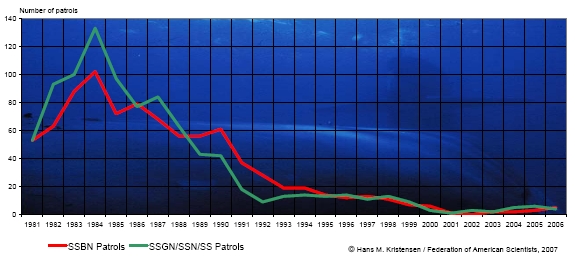 |
|
The annual number of patrols performed by
Russian nuclear-powered submarines has plummeted from 235 in
1984 to less than 10 today. In 2002, the strategic submarine
force did not manage to send a single boat on deterrent
patrol. (click
on graph to download PDF version) |
Patrol Areas
During the Cold War, the patrol areas for Soviet
ballistic missile submarines gradually changed as new capabilities were
introduced. Most important was the range of the missile, which permitted
the submarines to pull back into patrol areas ("bastions") closer to the
Soviet Union.
|
Mid-1960s -
1970
Golf SSB/Hotel SSBN Patrol Areas |
 |
|
|
1970s -
mid-1980s
Yankee SSBN Patrol Areas |
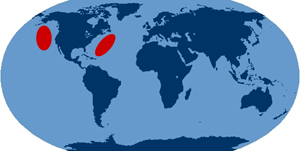 |
|
|
Mid-late-1980s
Yankee/Delta I SSBN Patrol Areas |
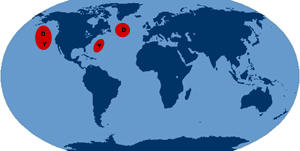 |
|
|
Late-1980s
Yankee/Delta II/III SSBN Patrol Areas |
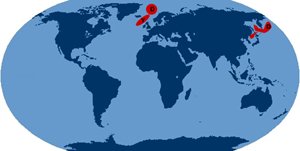 |
|
|
Late-1980s
and 1990s
Delta IV/Typhoon SSBN Patrol Areas |
 |
|
The maps and descriptions are based on: "Anti-Submarine
Warfare," The National Museum of American History, 2000;
Thomas B. Cochran, et al., Nuclear Weapons Databook Volume IV: Soviet
Nuclear Weapons (New York: Harper & Row, 1989). |
The first classes of Soviet ballistic missile
submarines were the Golf SSB and Hotel SSBN. Both carried the 1,400
kilometer SS-N-5 missile (from the mid-1960s). In the Atlantic they
patrolled off the U.S. east coast in an area ranging from Florida to
Maine some 300 kilometers from the coast. The Pacific patrol area ranged
from Mexico to Canada. (see right-top map)
With the arrival of the Yankee SSBN in the late 1960s,
the patrol areas changed. Equipped with the 3,000 kilometer range
SS-N-6, the boats normally operated further from shore and covered a
greater area. Typically, 2-3 Yankees patrolled the Atlantic coast and 2
boats patrolled off the Pacific coast. One of the Pacific boats would
patrol to the north-east with the other sometimes as far as to the west
of Hawaii. (see second map to the right)
Delta I SSBNs began deploying into the Atlantic in the
mid-1980s where they took over the northern part of the area previously
covered by Yankee SSBNs, but further north in an area east off
Newfoundland and south of Greenland. Equipped with the 9,100 kilometer
range SS-N-8, the Deltas were capable of striking targets throughout the
United States from their forward patrol areas. (see third map to the
right)
In the late 1980s, Russian SSBNs pulled back from the
United States. In the Atlantic, Delta II and III SSBNs began patrolling
in the Norwegian Sea in an area between Norway, Greenland, and Svalbard.
In the Pacific, the Delta SSBNs pulled back to patrol areas near the
Kamchatka Peninsula and in the Sea of Japan. The Delta II carried the
SS-N-8 and the Delta III was equipped with the 6,500 kilometer range
SS-N-18. The SS-N-6-equipped Yankee SSBNs in the Atlantic took on a new
"theater" mission against targets in western Europe, presumably in
response to the NATO deployment of cruise missiles. (see fourth map to
the right)
Finally, in the late 1980s and 1990s, the Delta IV and
Typhoon SSBNs equipped with 8,300 kilometer range SS-N-23 and SS-N-20,
respectively, pulled into what was known as a "strategic bastion"
north-east of the Kola Peninsula. Delta III SSBNs in the Pacific
continued patrolling in areas around the Kamchatka Peninsula and the
northern parts of the Sea of Japan.
Beyond increased missile ranges, the Russian
"withdrawal" of SSBN patrol areas may also have been an reaction to the
U.S. Navy's aggressive maritime strategy, which explicitly tasked U.S.
attack submarines with hunting down and destroying Russian SSBNs early
on in a war. Limited patrol areas presumably made it easier for Russian
attack submarines to protect the SSBNs.
But as the annual patrol graph above illustrates,
Russia sent fewer and fewer SSBNs on patrol in the late 1980s and first
half of the 1990s. Between 1988 and 1993, for example, the total number
of deterrent patrols dropped from around 60 to less than 20. Patrols
continued to decline after that until they came to a halt in 2002. After
that, a couple of patrols have been carried out each year, probably one
in both the Northern Fleet and Pacific Fleet. Rather than serve
strategic deterrence objectives, however, the low number of patrols may
be exercise operations intended to maintain a minimum level of
proficiency to carry out deterrent patrols if necessary. Shorter
deployments closer to homeport may also be taking place for training
purposes.
|
Delta IV
Class
Ballistic Missile Submarine |
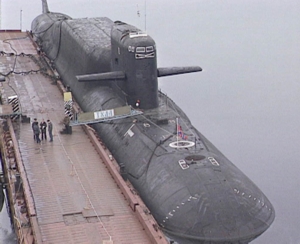 |
|
Russian nuclear submarines are spending most of
their life at pier side. |
Some Implications
Like strategic submarines of the other nuclear weapons
states, Russian ballistic missile submarines have the capability to
launch their missiles from pier side. A strategy that relies on this
capability, however, limits the number of targets that can be attacked
and exposes the boats to counter attack. It essentially eliminates the
retaliatory strike role of the submarines. Sending the boats to sea in a
crisis, on the other hand, would expose them to hostile attack
submarines. And the skills needed to evade those submarines erode each
year the strategic submarines stay in port or only carry out a few
patrols.
On the other hand, not sending the submarines
on extended deterrent patrols is a very powerful message if Russia wants
to signal that it is not a strategic threat. It is one less argument for
U.S. and British admirals to justify sending their attack submarines to
monitor and potentially counter Russian strategic submarines during
patrol. And it reduces the risk of accidents and incidents. Finally, it
might also indicate that the Cold War is over and the Russian Navy has
decided it simply doesn't need to deploy SSBNs on deterrent patrols
anymore.
If and when Russia resumes routine strategic submarine
patrols at a more significant level (which the other nuclear weapons
states have continued in the meantime), "prudent" military planning will
almost certainly result in western attack submarines being sent to trail
them on their patrols.
|

